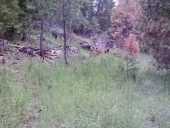
 1
1




Life is Hard, Its Harder if your stupid - John Wayne
If prepping doesn't make your life better, your doing it wrong - Me
 3
3




What plants can we use in a walnut guild?
There are plenty of plants not affected by juglone that we can use in the food forest.
Toby Hemenway described an interesting plant guild for a walnut tree in his book, Gaia’s Garden – a Guide to Home Scale Permaculture.
It consists of:
Walnut – English or Black Walnut (Juglans spp.) – for nuts
Hackberry – food for wildlife
Wolfberry – food for wildlife and medicine
Peppers or tomatoes
Elaeagnus (Elaeagnus spp.)
Mulberry – for fruit or fodder
Currants – for fruit
Elderberry – for very edible flowers and fruit
Gaias Garden A Guide to Home-Scale Permaculture, walnut guild 2nd Edition Toby Hemenway

I think that Toby Hemenway made a mistake recommending tomatoes in this guild, as tomatoes are very sensitive to juglone. Otherwise it is quite good, though it could be improved even more by adding more productive shrubs and an edible ground cover layer.

Permaculture walnut guild blackcurants
Walnut, black currant, red currant and nettles.
I recommend:
Pecan or Walnut – English or Black, for nuts
Huckleberry for wildlife food
Autumn olive, gumi, or Seaberry for nitrogen fixation and tasty fruit
Goji plant for tasty goji berries (superfood)
Mullbery for fruit or fodder (berries and leaves)
Elderberry for flowers and fruit
Black currants for fruit
White currants for fruit
Red currants for fruit
Gooseberry for fruit
Fiddlehead ferns (ostrich fern, royal fern) for edible, asparagus-like young shoots
Borage for greens, medicinal value and pollination
Nettles for medicinal value, animal fodder, survival food and an insect attractant
Just remember, for this guild to work well, we need fertile soil with plenty of water…
A human being should be able to change a diaper, plan an invasion, butcher a hog, conn a ship, design a building, write a sonnet, balance accounts, build a wall, set a bone, comfort the dying, take orders, give orders, cooperate, act alone, solve equations, analyze a new problem, pitch manure, program a computer, cook a tasty meal, fight efficiently, die gallantly. Specialization is for insects.
-Robert A. Heinlein
 1
1




Life is Hard, Its Harder if your stupid - John Wayne
If prepping doesn't make your life better, your doing it wrong - Me
 2
2




Iterations are fine, we don't have to be perfect
My 2nd Location:Florida HardinessZone:10 AHS:10 GDD:8500 Rainfall:2in/mth winter, 8in/mth summer, Soil:Sand pH8 Flat








Earthworks are the skeleton; the plants and animals flesh out the design.

|
permaculture is a more symbiotic relationship with nature so I can be even lazier. Read tiny ad:
Play Your Way to a Sustainable Lifestyle: Uncover Permaculture Principles with Each Card
https://gardener-gift.com/
|






